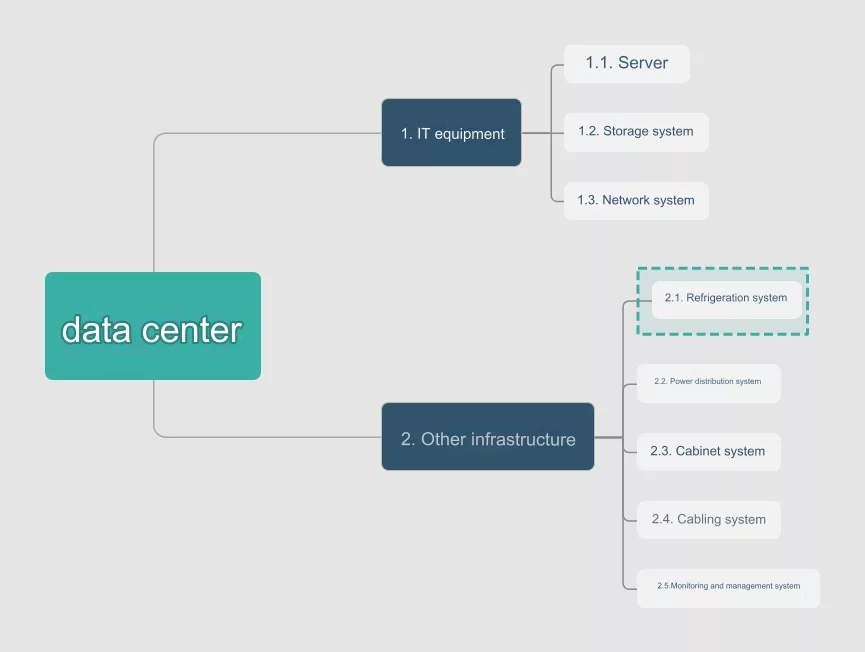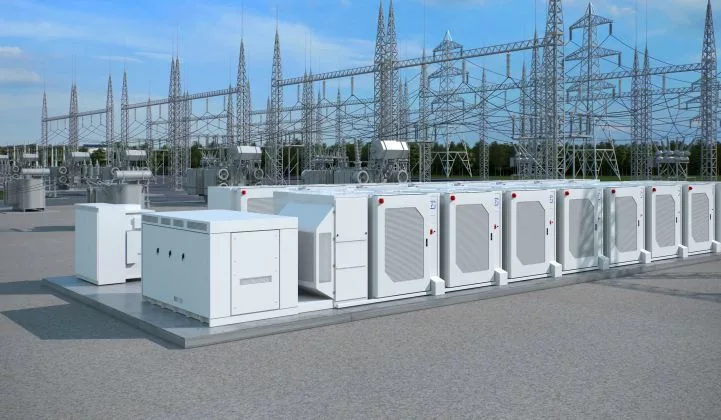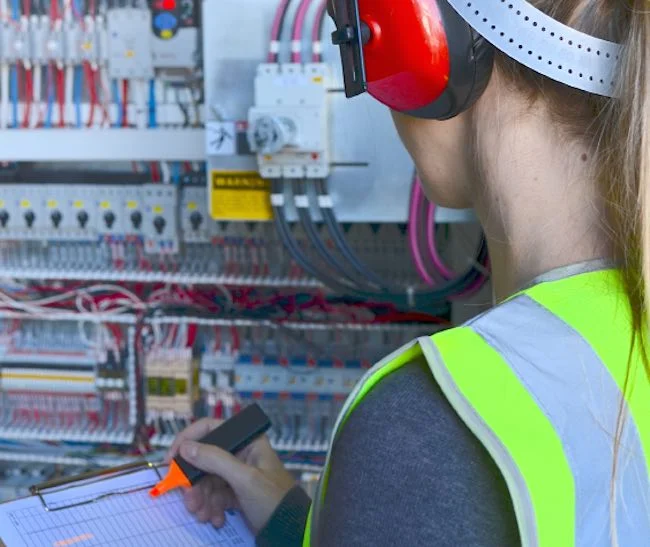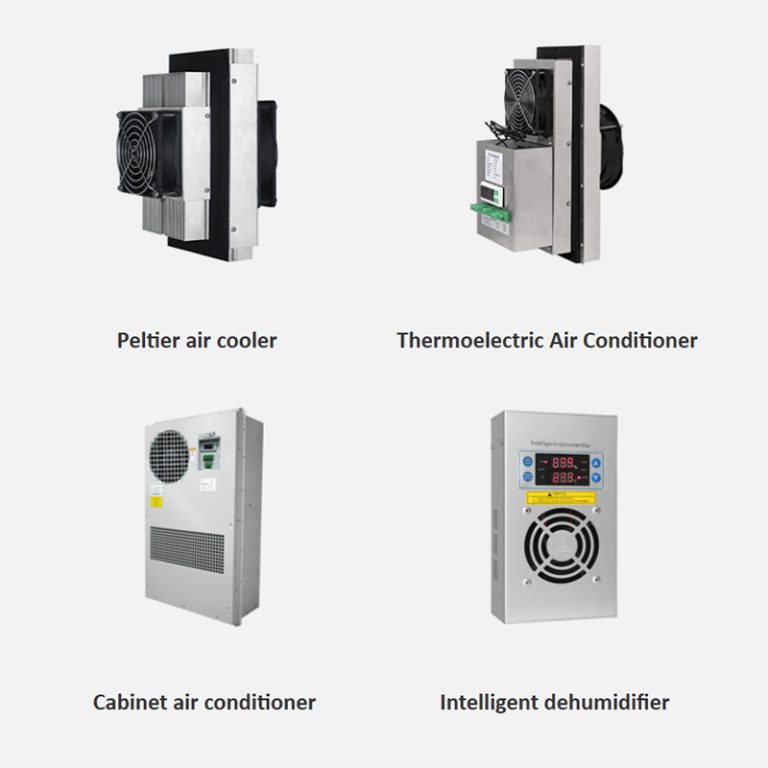Liquid cooling mainly refers to the use of prepared special liquids to take away the heat generated by the operation of heating devices such as CPUs, chipsets, and batteries through specific pipelines. It can be mainly used in energy storage and digitalization-related industries.
Liquid cooling can dissipate heat and cool the IT equipment in the data center to ensure the normal operation of the data center (DataCenter).

Datacenter framework
Cooling technology includes air cooling, water cooling, natural cooling, and liquid cooling. Among them, liquid cooling technology can be divided into two categories: “indirect contact type” and “direct contact type” according to the contact method between the liquid and the heating device. Immersion and spray liquid cooling are contact liquid cooling, and cold plate liquid cooling is non-contact liquid cooling.
(1) Immersion liquid cooling: Immersion liquid cooling immerses all the heating elements of IT equipment in the coolant to dissipate heat. It is divided into single-phase and phase change liquid cooling according to whether the working fluid undergoes phase change. The coolant after absorbing heat is cooled or condensed by air cooling or water cooling.
(2) Spray liquid cooling: Spray liquid cooling relies on pump pressure or gravity drive to accurately spray coolant from top to bottom to IT equipment circuit boards according to the needs of heating components. The heat-absorbing coolant is air-cooled or water-cooled. Circular cooling in the same way.
(3) Cold plate liquid cooling: Cold plate liquid cooling is non-contact liquid cooling, and the cooling liquid does not come into direct contact with the heating device. Cold plate liquid cooling uses flow channels to direct the coolant to the cold plate that is in contact with the heating elements of the IT equipment to dissipate the heat. The coolant after absorbing the heat is circulated and cooled through air cooling or water cooling.
Cold plate liquid cooling has the highest maturity, and immersion liquid cooling and spray liquid cooling have better energy-saving effects. Currently, among the three different types of liquid cooling, the cold plate liquid cooling heating device does not need to be in contact with the coolant. It is the earliest in development and has a higher technological maturity. The cold plate liquid cooling uses micro-channel enhanced heat exchange technology and has extremely high heat dissipation performance. It is used in military radars, high-density data centers, high-performance computers, power batteries, and high-power LED cooling fields. It is an effective application solution to solve the deployment of high-power consumption equipment, improve energy efficiency, reduce cooling operating costs, and reduce TCO; immersed And spray liquid cooling achieves 100% liquid cooling, with a better energy saving effect. Immersion liquid cooling has obvious advantages in heat dissipation and energy saving, and has been widely used in the fields of supercomputing and high-performance computing; spray liquid cooling has relatively few publicly displayed research results and application practices.
Compared with air cooling, liquid cooling has the advantages of low energy consumption, high heat dissipation, low noise, and low TCO. The cooling capacity of liquid is 1000 to 3000 times that of air. Liquid cooling technology can achieve the advantages of high density, low noise, low heat transfer temperature difference and universal natural cooling. It has incomparable technical advantages over air cooling technology. It is a kind of technology that can be applied to applications that need to greatly improve computing power, energy efficiency and Excellent cooling solution for deployment density and other scenarios.
The current proportion of air-cooled and liquid-cooled:
At present, the digital transformation of my country’s industry is accelerating, promoting the development of the IDC temperature control market. According to Industry Online, my country’s computer room special air conditioner market will have a CAGR of 9.28% in 2021, showing a rapid growth trend. The market size will reach 5.009 billion yuan in 2021, a year-on-year increase of 14.9%. Among them, according to the air-conditioning refrigeration method, air-cooled and refrigerated in 2021 The proportions of water and other forms of air conditioning are 56.8%/30.81%/12.39% respectively, and air cooling still dominates.
In recent years, the share of air-cooled computer rooms has been declining year by year. With many advantages, liquid cooling technology is expected to continue to increase its penetration rate in data centers in the future and become a mainstream cooling technology.
At present, the cold plate technology is mature and leading the commercial implementation. According to data from the Qianzhan Industry Research Institute, in 2019, my country’s liquid-cooled data center technology was mainly cold plate type, accounting for more than 80%, and immersed type accounted for less than 20%. Immersion cooling is more efficient and has become the current research and development focus of mainstream manufacturers. It is a leapfrog technological innovation in data centers. It is expected that as technical solutions continue to mature, immersion will become a more important mainstream solution.
Sales : Mia






